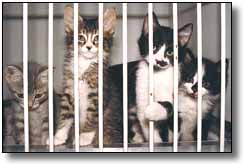Sept. 25, 1999
By David Grant Long Perhaps you remember the "Pound Puppy" craze a few years ago when people were fighting one another for a chance to buy the cute little stuffed animals, complete with a cute little certificate of adoption, for their cute little kids. Would that life were nearly as sweet and rosy for the real denizens of the Cortez Animal Shelter, where dozens of dogs and cats -- cute as well as engagingly ugly, little to extra large -- more or less patiently await a merciful rescue from local animal-lovers. Because if that doesn’t come within a week or so, a mercy killing -- or euthanasia, as it’s more euphemistically called -- is the fate of nearly half of the lost, abandoned and feral pets brought there. "The main thing is getting them spayed and neutered," shelter manager Andrea Jeter said rather wearily Thursday, surveying some of her feline charges with eyes saddened by witnessing hundreds of lovable but unwanted animals being "put down," as it’s called in the pound business. Jeter, who has managed the shelter since the city was forced to take over its operation two years ago, obviously possesses the passionate affection and dedication necessary to provide this all-too-often-terminal care for our most popular and, ironically, most mistreated companions. But she also displays anger over the circumstances that make the executions of so many of her temporary guests necessary. "The biggest reason the shelter gets animals is people moving," Jeter said indignantly. "They tell us, ‘Our new landlord won’t allow pets.’ "I just don’t understand how they can do that. Animals are just a commodity in our society -- we’ll get rid of this one and adopt another one in a couple months." And things are about to get even more crowded at the shelter, which already houses more than two dozen cats and kittens and about 20 dogs and puppies. "We’re starting to go back into a breeding season," Jeter explained, which accounts for three annual spikes in the pound’s population, with the two other intense breeding periods being in the spring and summer. "We had a lull (in the number of litters being brought in), but it’s starting to pick up again," she added, including a box of four-day-old kittens that had recently been left at Dawson Lake Store in the dead of night. Since kittens and puppies can’t be adopted until they’re at least eight weeks old and they can’t be kept at the shelter beyond the five-day (which often stretches to seven days or longer) holding period, she explained, those that are going to have any chance for adoption must be farmed out to "foster parents" until they are old enough. "And if we can’t find foster homes, they have to be put down," said Jeter, noting that she and her husband are currently keeping 11 dogs at their home and 10 other volunteers are also temporarily boarding pets to postpone their meeting with the Grim Reaper. In 1997, well over 1,500 pets were brought to the shelter, and 58 percent of those were killed, with the rest being either adopted or reclaimed; last year things improved somewhat, with less than half having to be put down, but that still meant that nearly 600 were given lethal injections. To encourage the neutering and spaying of adopted pets, the shelter requires a $20 deposit for dogs and $18 for cats that is refunded upon proof of having the procedure done; however, the average cost among local veterinarians for cats is $65 for spaying and $35 for neutering and, depending on the size, neutering of dogs runs from $62-$90, spaying from $76 to $130. Since the vets have traditionally been reluctant to put on low-cost spay/neuter clinics, Jeter and Cortez Police Commander Darrel Hinton have proposed a program that would assist people of limited means in paying the full price. If approved by the city, the program would use donations to subsidize the cost of these operations, Hinton explained, and the owner’s share would be based on the family’s income. "The program would only function as long as there are donations to do it," said Hinton, stressing that no public money would be involved. He said the proposal had been given the blessing of Chief Roy Lane and had just been forwarded to City Manager Hal Shepherd for consideration. There is presently more than $600 available for this purpose, he explained, and an annual fund-raiser to expand the effort is a possibility if there are no legal problems. There is also the possibility of obtaining grants for subsidizing spayings and neuterings, he said. The shelter can also always use donated blankets, towels, bleach, soap and pet food, Jeter said, which might free up a little money for "treats" and other small amenities that make the animals’ visits a bit more pleasant, despite their uncertain futures. During a tour of the tidy, revamped shelter, Hinton repeatedly pointed out how much cleaner and better-smelling it has been since Jeter took charge. Towels soaked in bleach are placed at the entrance to each of the facility’s various holding rooms to disinfect shoes, and the cages are regularly hosed down (with the animals removed, of course) to prevent the spread of disease. Now if only she could get rid of that faint smell of impending doom. |
|
|
